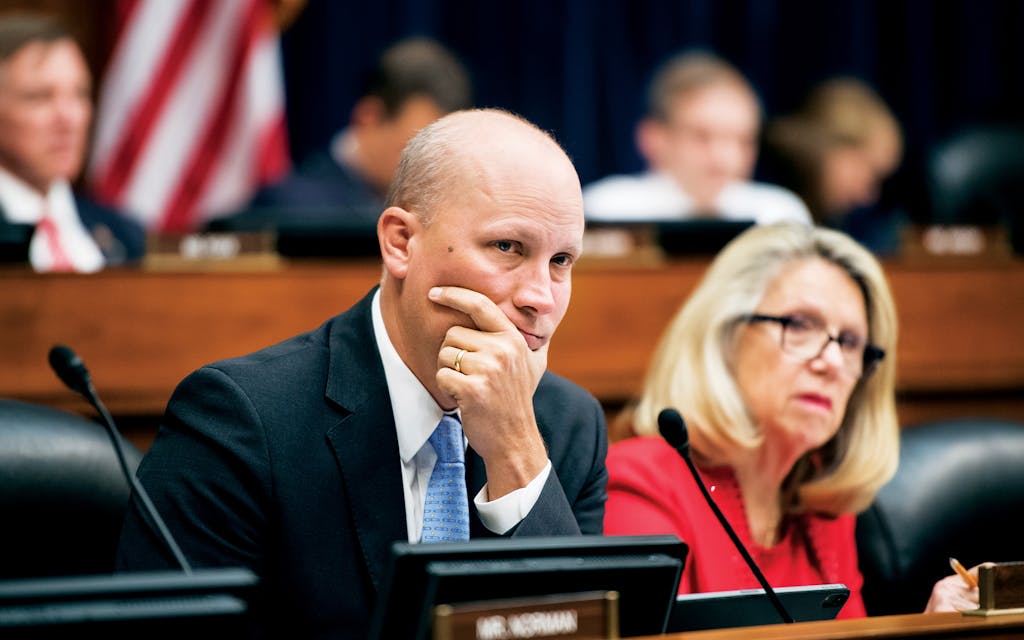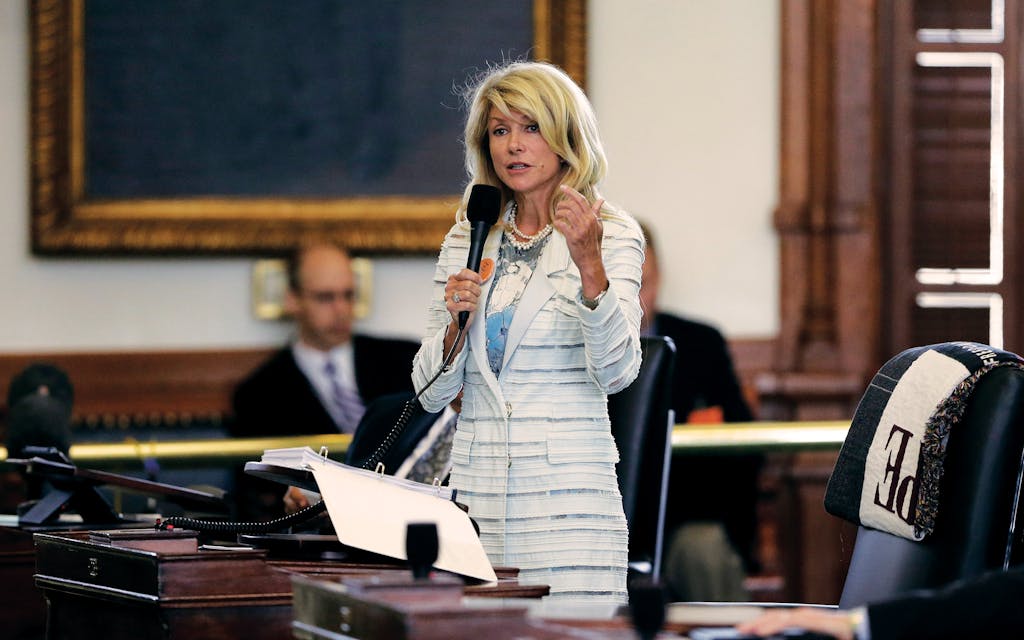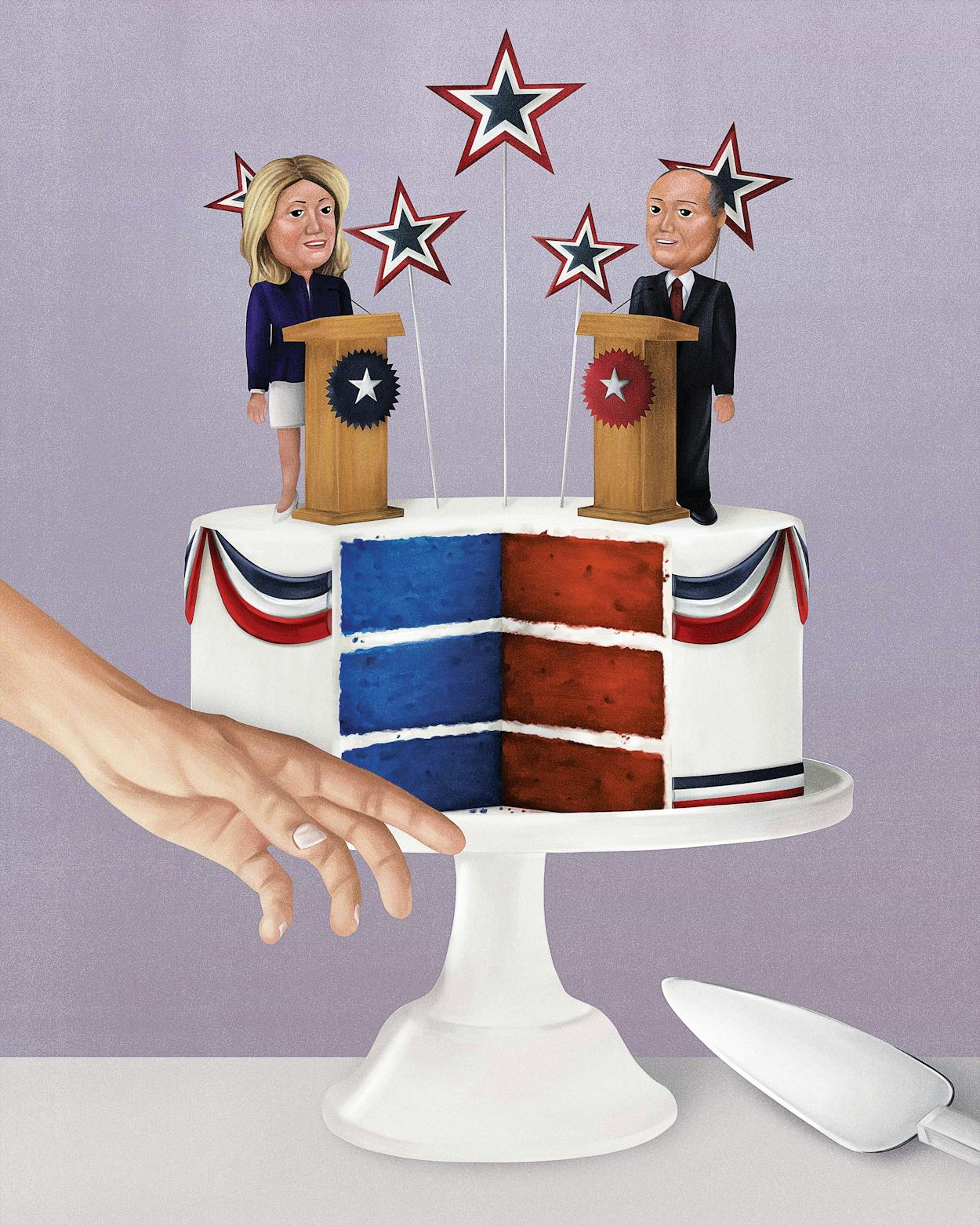Hi, beautiful friend,” Wendy Davis cooed to Connie Britton as soon as Davis joined the Friday Night Lights actress’s Instagram livestream. It was August 6, and Britton was hosting the former state senator as part of #TeamJoeTalks, a Joe Biden initiative to mobilize celebrities and their social media platforms during an election cycle in which we’re all encouraged to stay inside our homes.
The two feminist icons have a natural rapport; they’ve been friends and allies since Davis’s famous 2013 filibuster in the Texas Senate temporarily halted a sweeping anti-abortion bill, after which Britton launched a line of “What Would Tami Taylor Do?” T-shirts and donated proceeds to an abortion rights group. (Tami Taylor is the character Britton played on FNL.) Britton was floated as an obvious choice to play Davis in the inevitable biopic, before Lieutenant Governor Dan Patrick said he’d block any filming in the Senate chamber because Davis had already “disgraced it once.” Though the movie never got made, Britton and Davis have stayed in touch.
On the livestream, the two fiftysomething women discussed various issues known to fire up the liberal base: systemic racism, attacks on Planned Parenthood, and the way, as Davis put it, those in power put public health at risk “in a rush to get the economy moving for their own political well-being.”
“Two glorious, powerhouse women!!! Texan here. Voting blue!!!” wrote one commenter when the video was posted. “Please stop,” wrote another, evidently not a Davis fan.
That same week, Davis’s Republican opponent in the Twenty-first Congressional District, Chip Roy, was in something of a tiff with the San Antonio Express-News. The day before, the newspaper had run an editorial that claimed Roy had called the pandemic a hoax. The thing was, Roy hadn’t—well, not exactly. A week earlier, the freshman congressman had told conservative radio host Steve Deace that he thought COVID-19 fearmongering—not the disease itself, but the response to it—was a “fraud that is being perpetrated on the American people.” A few months prior he had also told Fox & Friends about “troubling” reports that the virus had been developed in a Chinese lab. But he never used the word “hoax,” so his campaign pressed the Express-News to print a correction, which it eventually did.
“Never called it a hoax, never would,” Roy told me on the patio of a Torchy’s Tacos in Austin, just outside the Twenty-first District, which stretches from the conservative, affluent enclaves of northeast San Antonio to liberal southwest Austin and out to the western fringes of the Hill Country. “Of course it’s real,” he said. But one could forgive an inattentive voter for assuming Chip Roy was the sort of guy who would call the pandemic a hoax. He has made a point of not wearing a mask, including at our outing to Torchy’s. (I opted to go maskless too.) He doesn’t shy away from his own brand of MAGA-adjacent politics. He’s called COVID-19 “the Wuhan virus” and compared stay-at-home orders to rights abuses during the Third Reich. In late August, he hosted a campaign event with Rafael Cruz—Ted’s dad—who likened the race to “a spiritual battle between right and wrong, between the word of God and the word of the enemy.”
Given that it’s 2020 and America seems to be unraveling, it’s perhaps not surprising that a prominent Roy supporter would seem to compare Davis to Satan herself. But the apocalyptic rhetoric is an interesting choice for a race that has been declared a toss-up in a traditionally Republican-leaning district that seems to be trending mildly left. The conventional wisdom might suggest that in such circumstances it would be wise to tack to the center, to seek out independents and moderate members of the opposing party. That’s what Democrat Joseph Kopser did when he took on Roy in 2018. An Iraq War veteran and technology entrepreneur who preaches the virtues of civility, Kopser supported lowering corporate tax rates and emphasized that “law-abiding gun owners have nothing to fear.” He deliberately sought out right-leaning voters and Republicans. He lost to Roy by 3 points.
Our politics have become so polarized and tribal that chasing the few voters who haven’t made up their minds just doesn’t make sense to some candidates; elections are about riling up the base, even, sometimes, in fifty-fifty races. The Davis-Roy battle represents a struggle between two symbols of the Texas left and right, both of whom have been major players in Texas politics for more than a decade, embodying the hopes, dreams, and fears of their respective parties.
In one corner, there’s Wendy Davis—she of the pink sneakers and national fame—attempting at least the third act of her political career. In the other, there’s Chip Roy, a libertarian-lite bulldog who is frequently described as a “new Ted Cruz.” He’s as red as a rose; she’s as blue as the state flower. And now they’re locked in a throwdown in a district that is neither.

Charles Eugene “Chip” Roy first became involved with Texas politics in his late twenties, after moving from Virginia to attend law school at the University of Texas at Austin and interning in the office of then–Texas attorney general John Cornyn. When he graduated in 2003, Roy followed Cornyn to Washington, where he worked as a staffer for the Senate Judiciary Committee. In 2009 he went to work as an adviser to Governor Rick Perry, and the next year he ghostwrote Fed Up!, Perry’s screed against the federal government that preceded his first presidential run. In 2012 freshman senator Ted Cruz picked Roy to serve as his chief of staff, a role that would see Roy guide Cruz through his filibuster-like speechifying against Obamacare (and the sixteen-day government shutdown it helped cause).
In 2014 Roy returned to the attorney general’s office, this time to work as a deputy for Ken Paxton. Roy did have a brief stint outside government: from 2016 to 2018 he worked as the director of the Center for Tenth Amendment Action at the Texas Public Policy Foundation, a right-wing think tank that often serves as a way station for politicians (Ted Cruz ran the center before running for U.S. Senate).
Roy’s résumé neatly brackets the era of total GOP domination of Texas politics. Jim Henson, the director of UT’s Texas Politics Project, categorizes Roy, who is 48, as part of “the younger generation of Republicans in the state that had no socialization with any kind of system of shared power” or political competition. What Roy learned from Perry, Paxton, and Cruz, Henson says, is that it pays to “play directly to the base and run as far to the right as you can.”
In 2018, after Roy decided to become a candidate, he embraced that playbook. The GOP primary for the Twenty-first Congressional District seat that Republican Lamar Smith had held for three decades before announcing his retirement in 2017 was crowded with eighteen conservatives eager to stroll past the general election into Congress. Early polls didn’t look good for Roy, but he soon scored endorsements from Cruz and Utah senator Mike Lee, Cruz’s tea party ally in the Senate. In radio and TV ads, Roy marketed himself as a “proven conservative” who “knows the dangers of illegal immigration and will fund President Trump’s border wall.” The Trump-friendly signaling paid off; Roy eventually defeated the more subdued Matt McCall in the runoff by 5 percentage points. But in the general, he bested Kopser by just 9,233 votes—a warning sign that the seat was no longer an easy hold for Republicans.
Once in Congress, Roy cast himself as an enemy of the new Democratic majority in the House, a.k.a. “the swamp.” But Roy himself seemed to get stuck in the muck. Within months of his swearing in, he had single-handedly delayed a piece of disaster relief legislation that had already passed in the Senate, echoing Cruz’s adversarial first term. Roy’s main objection was procedural; he didn’t like the fact that Nancy Pelosi had called for the vote on a Friday before a recess, when many House members had already left town. He also complained that the bill didn’t include border security funding.
Never mind that the bill had overwhelming bipartisan support and that both Cornyn and Cruz had voted in favor of it—no doubt in part because it freed up $4 billion in recovery funding for Houston and other parts of Texas hurt by Hurricane Harvey. Roy’s protest was lonely, but that seemed to be the point: like his mentor Cruz, he wanted to be seen as a new kind of Texas maverick, someone who didn’t mind shutting down the system to send a message.

If Chip Roy is the embodiment of the direction the Texas GOP has gone in the past decade, Wendy Davis is the poster child of Texas Democrats. In 2013 she catapulted herself to international fame when she put on those pink sneakers, but Texas Democrats had considered her a star long before that. The New York Times dubbed her “an overnight celebrity” for a completely different filibuster (on a school finance bill) two years before #StandWithWendy was a trending topic on Twitter. And as far back as 2008, when Davis beat a cigar-chomping member of the Legislature’s good ol’ boys club for a state Senate seat in a Republican-leaning Fort Worth district, liberals were already predicting that her win was an early example of the long-promised and long-
elusive blue-ing of the Texas electorate.
But it was the abortion filibuster that gave her the kind of national profile most state-level politicians only dream of. Within months, she had decided how to spend that capital, announcing that she would be taking on then–attorney general Greg Abbott and his $20 million war chest in the governor’s race. If she succeeded, she’d be the first Democrat in two decades to win statewide office in Texas. But it didn’t turn out that way. Davis lost to Abbott by 20 points, a greater margin than any Democratic gubernatorial candidate since Gary Mauro, in 1998. Her national support and robust fund-raising didn’t appear to matter—and, in fact, her celebrity endorsements may have turned off many Texans.
Afterward, Davis seemed to have decided that her decision to run in the mushy middle—she largely avoided talking about reproductive rights until the homestretch of the campaign and loudly supported measures to allow the open carrying of handguns—deflated her supporters, women in particular.
Davis later wrote in an essay for Politico that her open carry stance was “a position that haunts me.” This time, she told me over Zoom, “I’m running one hundred percent authentically on the things that matter the very most to me, versus, you know, what a well-intentioned and very smart polling expert might say.”
But it’s not a sure bet. Many of the attributes that made Davis vulnerable in 2014 are still a problem in 2020. The right continues to dog her for her stance on abortion and her chumminess with celebrities. Before Davis even announced her candidacy last year, the Roy campaign put out a fund-raising ad that referred to her as an “abortion extremist” and said her candidacy would be “a dream come true for liberal Hollywood and Manhattan elites who want to turn Texas blue.” As the race has gone on, Roy has only doubled down, accusing Davis of being in the pocket of everyone from Nancy Pelosi to financier George Soros.
Such a line of attack makes some sense. The Twenty-first Congressional District hasn’t elected a Democrat to Congress since 1976, and in a hyperpolarized environment, running in the middle of the road can get a candidate like Roy run over. Just ask 2014 Wendy. But catering to one’s base is risky too. In the past decade, the district’s population has grown by 17 percent, turning a mostly rural district mostly suburban. The demographic makeup has also changed: the electorate is now younger and more diverse and boasts higher rates of college graduation, all of which favor the Democratic party.
And then there’s the elephant in the room: Donald J. Trump, who will almost certainly make things harder for Roy. “Clearly, Donald Trump represents a drag on most of the Republican candidates in Texas,” says Mark P. Jones, a professor of political science at Rice University. Roy already underperformed as a GOP candidate in 2018, and “with President Trump pulling the entire Republican ticket down, that baseline may be narrower, and thus Roy’s cushion all the smaller.”
Recently, Roy has changed his tune a bit by trying to distance himself from the top of his party’s ticket. His first official TV ad, released in September, made no mention of the border wall, the Wuhan virus, or any other red-meat rhetoric that could bind him to Trump. Instead, Roy promised to “hold my party accountable if they’re wrong and work across party lines when it’s right for Texas.”
The feint away from Trump, says UT’s Henson, “is an implicit acknowledgment that there are concerns he cannot win with his base alone. On one hand, that’s a typical general election play. But it’s an interesting judgment about the district, because Republicans have generally not needed to do that very much.”
Roy still needs his base, but it might not be big enough to win in 2020. Davis has her own stretch goals. She needs what every Texas Democrat in a potential swing district needs: a large enough coalition of diverse voters, young people, and moderates who are tired of the forever-rightward drift that defined Texas politics in the 2010s. During our Zoom call, Davis offered a bold prediction. “I’m just gonna put myself out there on a limb and say this to you right now,” she said. The Twenty-first District will be among “at least five congressional seats” that Texas Democrats turn from red to blue, she told me as she raised five fingers. Down-ballot wins, in turn, will “deliver the state” to Joe Biden, and Texas will turn blue, “district by district by district.” She leaned toward the camera until I could see the reflection of the professional lighting setup in her eyeglasses. She smiled her winningest smile.
Additional Election Coverage:
Check out Our “Get to Know a Swing District” Series
Candidates Face Tough Choices About How to Campaign During a Pandemic.
How Texas’s 150-year history of voter suppression has brought us to this moment
The Biggest Fight in the State? Control Over the Texas House.
This article originally appeared in the November 2020 issue of Texas Monthly with the headline “Swing Dance.” Subscribe today.
- More About:
- Politics & Policy
- Wendy Davis
- Chip Roy
- San Antonio
- Austin









